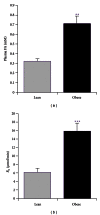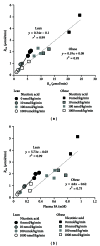Roles of Fatty Acid oversupply and impaired oxidation in lipid accumulation in tissues of obese rats
- PMID: 23762564
- PMCID: PMC3666279
- DOI: 10.1155/2013/420754
Roles of Fatty Acid oversupply and impaired oxidation in lipid accumulation in tissues of obese rats
Abstract
To test the roles of lipid oversupply versus oxidation in causing tissue lipid accumulation associated with insulin resistance/obesity, we studied in vivo fatty acid (FA) metabolism in obese (Obese) and lean (Lean) Zucker rats. Indices of local FA utilization and storage were calculated using the partially metabolizable [9,10-(3)H]-(R)-2-bromopalmitate ((3)H-R-BrP) and [U-(14)C]-palmitate ((14)C-P) FA tracers, respectively. Whole-body FA appearance (R a ) was estimated from plasma (14)C-P kinetics. Whole-body FA oxidation rate (R ox) was assessed using (3)H2O production from (3)H-palmitate infusion, and tissue FA oxidative capacity was evaluated ex vivo. In the basal fasting state Obese had markedly elevated FA levels and R a , associated with elevated FA utilization and storage in most tissues. Estimated rates of muscle FA oxidation were not lower in obese rats and were similarly enhanced by contraction in both lean and obese groups. At comparable levels of FA availability, achieved by nicotinic acid, R ox was lower in Obese than Lean. In Obese rats, FA oxidative capacity was 35% higher than that in Lean in skeletal muscle, 67% lower in brown fat and comparable in other organs. In conclusion, lipid accumulation in non-adipose tissues of obese Zucker rats appears to result largely from systemic FA oversupply.
Figures





Similar articles
-
Lipid metabolism in the obese Zucker rat. Disposal of an oral [14C]triolein load and lipoprotein lipase activity.Biochem J. 1991 Mar 15;274 ( Pt 3)(Pt 3):651-6. doi: 10.1042/bj2740651. Biochem J. 1991. PMID: 2012594 Free PMC article.
-
Increased fatty acid uptake and altered fatty acid metabolism in insulin-resistant muscle of obese Zucker rats.Diabetes. 2001 Jun;50(6):1389-96. doi: 10.2337/diabetes.50.6.1389. Diabetes. 2001. PMID: 11375340
-
Diazoxide enhances basal metabolic rate and fat oxidation in obese Zucker rats.Metabolism. 2008 Nov;57(11):1597-607. doi: 10.1016/j.metabol.2008.06.017. Metabolism. 2008. PMID: 18940400
-
Contribution of hyperinsulinemia to modulation of lipoprotein lipase activity in the obese Zucker rat.Metabolism. 2000 Jan;49(1):134-40. doi: 10.1016/s0026-0495(00)91013-8. Metabolism. 2000. PMID: 10647077
-
Effect of 5-aminoimidazole-4-carboxamide-1-beta-D-ribofuranoside infusion on in vivo glucose and lipid metabolism in lean and obese Zucker rats.Diabetes. 2001 May;50(5):1076-82. doi: 10.2337/diabetes.50.5.1076. Diabetes. 2001. PMID: 11334411
Cited by
-
Nicotinic acid timed to feeding reverses tissue lipid accumulation and improves glucose control in obese Zucker rats[S].J Lipid Res. 2017 Jan;58(1):31-41. doi: 10.1194/jlr.M068395. Epub 2016 Nov 15. J Lipid Res. 2017. PMID: 27875257 Free PMC article.
-
Perilipin 5 fine-tunes lipid oxidation to metabolic demand and protects against lipotoxicity in skeletal muscle.Sci Rep. 2016 Dec 6;6:38310. doi: 10.1038/srep38310. Sci Rep. 2016. PMID: 27922115 Free PMC article.
-
The SGLT2 inhibitor dapagliflozin promotes systemic FFA mobilization, enhances hepatic β-oxidation, and induces ketosis.J Lipid Res. 2022 Mar;63(3):100176. doi: 10.1016/j.jlr.2022.100176. Epub 2022 Feb 2. J Lipid Res. 2022. PMID: 35120993 Free PMC article.
-
The effect of high-fat--high-fructose diet on skeletal muscle mitochondrial energetics in adult rats.Eur J Nutr. 2015 Mar;54(2):183-92. doi: 10.1007/s00394-014-0699-7. Epub 2014 Apr 18. Eur J Nutr. 2015. PMID: 24743896
-
G0/G1 Switch Gene 2 controls adipose triglyceride lipase activity and lipid metabolism in skeletal muscle.Mol Metab. 2016 Apr 22;5(7):527-537. doi: 10.1016/j.molmet.2016.04.004. eCollection 2016 Jul. Mol Metab. 2016. PMID: 27408777 Free PMC article.
References
-
- Kraegen EW, Cooney GJ. Free fatty acids and skeletal muscle insulin resistance. Current Opinion in Lipidology. 2008;19(3):235–241. - PubMed
-
- Lam TKT, Carpentier A, Lewis GF, Van de Werve G, Fantus IG, Giacca A. Mechanisms of the free fatty acid-induced increase in hepatic glucose production. American Journal of Physiology. 2003;284(5):E863–E873. - PubMed
-
- Assimacopoulos-Jeannet F. Fat storage in pancreas and in insulin-sensitive tissues in pathogenesis of type 2 diabetes. International Journal of Obesity. 2004;28(supplement 4)(4):S53–S57. - PubMed
-
- Ginsberg HN, Zhang YL, Hernandez-Ono A. Regulation of plasma triglycerides in insulin resistance and diabetes. Archives of Medical Research. 2005;36(3):232–240. - PubMed
LinkOut - more resources
Full Text Sources
Other Literature Sources

